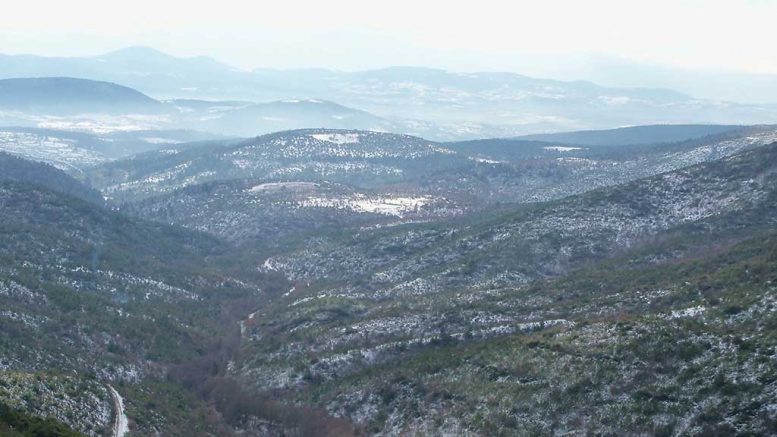Alamos Gold (TSX: AGI; NYSE: AGI) has made its precious metals portfolio in Turkey more attractive by publishing positive feasibility studies on the stand-alone Kirazli and Agi Dagi open-pit heap-leach projects, along with a preliminary economic assessment (PEA) on the Camyurt project. All three are in the Canakkale province of northwestern Turkey.
“With Kirazli, followed by Agi Dagi and Camyurt, we own a pipeline in Turkey that can provide low-cost production and free cash flow for more than a decade,” Alamos’ president and CEO John McCluskey said in a release.
Building on the previous 2012 prefeasibility studies, the February 2017 feasibility studies indicate improved economics, despite incorporating lower metal price assumptions of US$1,250 per oz. gold and US$16 per oz. silver, and a higher 8% discount rate, versus 5%.
BMO analyst Brian Quast writes that unit mining costs and operating costs for both Kirazli and Agi Dagi improved over 2012, due to three factors: pit slope design and lower waste-to-ore ratios, foreign-exchange assumptions that reflected the depreciation of the Turkish lira and lower mining contractor rates.
Alamos envisions Kirazli, the most advanced of the three, as a 15,000-tonne-per-day heap-leach operation, with start-up costs of US$152 million.
Based on maiden reserves of 670,000 oz. gold and 10.1 million oz. silver (26.1 million tonnes grading 0.79 gram gold and 12 grams silver per tonne), gold production should average 104,000 oz. a year over a five-year mine life. Mine-site all-in sustaining costs (AISCs) are US$373 per oz., minus silver credits. This marks a 30% decline from 2012’s US$535 per ounce.
On an after-tax basis, Kirazli boasts a US$187-million net present value (NPV) and 44% internal rate of return (IRR). Payback should occur within 1.4 years.
Applying the same metal price assumptions and discount rate to the 2012 study, Kirazli’s economics have improved from the after-tax NPV and IRR of US$82 million and 26%.
The feasibility study on the Agi Dagi project, 25 km southeast of Kirazli, forecasts it would cost US$250 million to build a 30,000-tonne-per-day heap-leach operation, with a six-year mine life.
Based on a maiden reserve of 1.17 million oz. gold and 9.5 million oz. silver (54.4 million tonnes of 0.67 gram gold and 5.4 grams silver), Agi Dagi could annually churn out 177,600 oz. gold over five years of production. Expected mine-site AISCs are US$411 per oz., net of silver credits. This reflects a 35% reduction from 2012.
Using an 8% discount rate and the same 2017 metal price assumptions, Agi Dagi’s after-tax NPV has climbed 240% since 2012 to US$298 million. The after-tax IRR has jumped 23% to 39%. Expected payback is less than two years.
While acknowledging the better economics, Ryan Hanley, an analyst at Mackie Research Capital, says that “we continue to be cautious on permitting for both Kirazli and Agi Dagi, sticking to our ‘when, not if’ belief — which has proven the correct approach, given ongoing delays.”
Alamos notes the federal government has approved Kirazli’s environmental impact study (EIA) and forestry permits. It is now waiting for the business opening and operation (GSM) permit. Once that is in hand, Alamos will provide a 2017 development budget for the project. Kirazli should take nearly two years to bring online, after a construction decision.
Meanwhile, Agi Dagi has an approved EIA, but the GSM and forestry permits remain outstanding.
BMO’s Quast says the company intends to permit the projects separately, as combining the two would require an amended EIA. Alamos also plans to use the cash flow from Kirazli to fund Agi Dagi’s development.
Alamos says Agi Dagi has a 36-month development timeline, including three months of pre-commercial production, after a construction decision.
Mackie’s Hanley says Kirazli would start up in 2020, followed by Agi Dagi in 2021.
The PEA on the Camyurt project, 4 km from Agi Dagi, assumes Camyurt could annually produce 93,200 oz. gold and 403,000 oz. silver over four years, based on measured and indicated resources of 510,000 oz. gold and 3.5 million oz. silver (17.7 million tonnes at 0.89 gram gold and 6.1 grams silver).
Expected initial capital is US$10 million, reflecting no infrastructure requirements. Alamos plans to truck the ore from Camyurt to Agi Dagi’s plant, after Agi Dagi runs its course.
On an after-tax basis, Camyurt has an US$86-million NPV and a 253% IRR.
“Relative to the economics of Agi Dagi, as a smaller operation Camyurt does not display the same attractiveness, despite the higher grade,” Quast says.
He points out that Camyurt will have higher mining costs, due to a higher strip ratio and haulage costs related to trucking ore to Agi Dagi. Camyurt’s estimated mine-site AISCs are US$645 per oz. — nearly 60% higher than Agi Dagi’s.
Given the smaller size of capital outlay, Camyurt’s corporate tax rate will remain Turkey’s statutory 20%, while Kirazli and Agi Dagi both have the lower 2% tax rate, Quast notes.
Alamos closed Feb. 22 — the day it released the Agi Dagi and Camyurt studies — up 3¢ at $10.56 per share. It published Kirazli’s study a week earlier.
Quast has a $14.25 target and “outperform” rating on the stock, while Hanley has an $11 target and a “hold” on Alamos. He says the company has limited growth until 2018.
Along with its Turkey assets, Alamos operates the Mulatos and El Chanate mines in Mexico, and the Young-Davidson mine in Ontario.


Be the first to comment on "Alamos Gold improves economics at Kirazli and Agi Dagi"